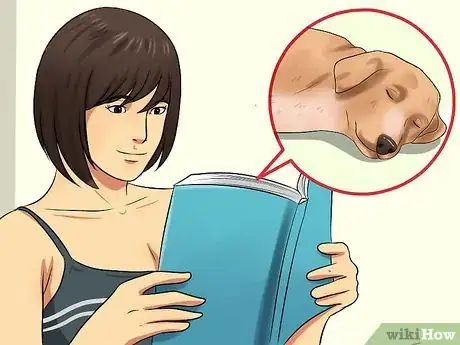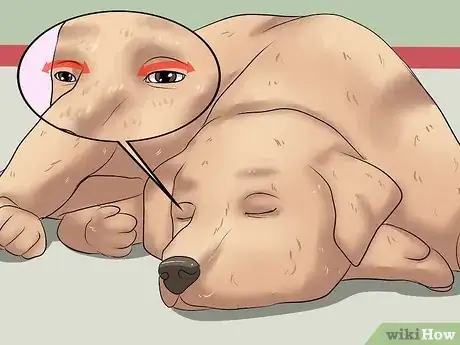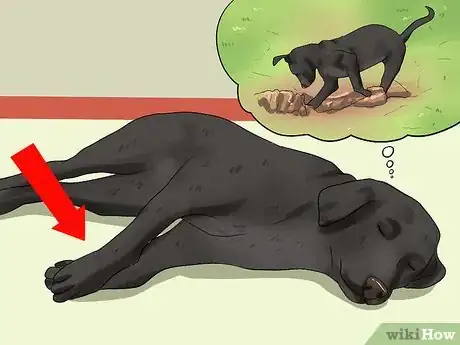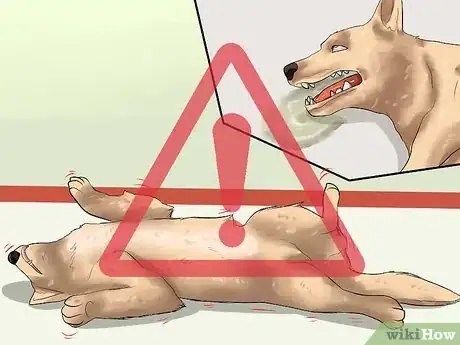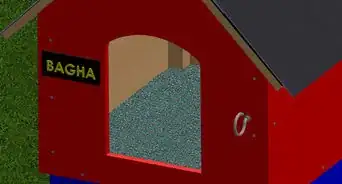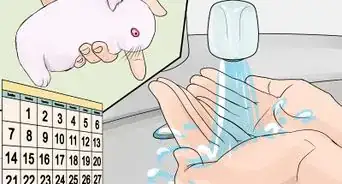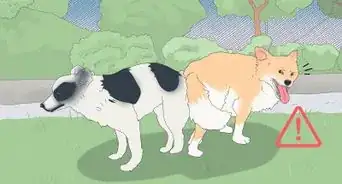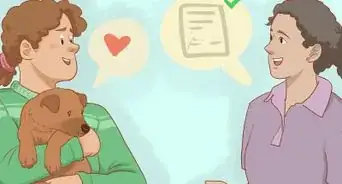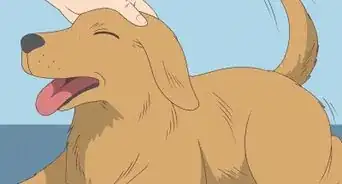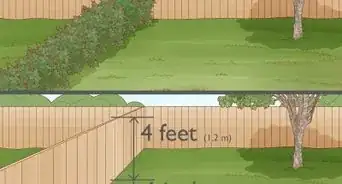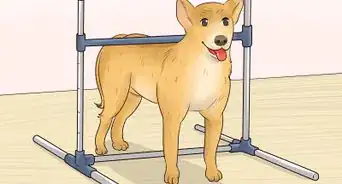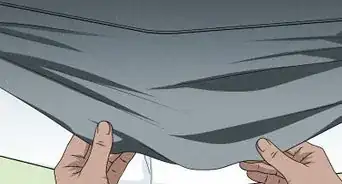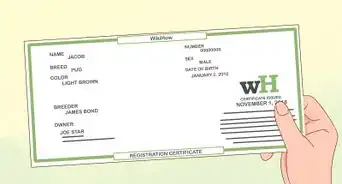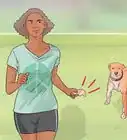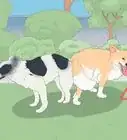This article was co-authored by Pippa Elliott, MRCVS. Dr. Elliott, BVMS, MRCVS is a veterinarian with over 30 years of experience in veterinary surgery and companion animal practice. She graduated from the University of Glasgow in 1987 with a degree in veterinary medicine and surgery. She has worked at the same animal clinic in her hometown for over 20 years.
This article has been viewed 131,539 times.
Have you ever wondered if dogs could dream? Have you ever looked at your dog when he was sleeping, wondering if he was chasing after something? Interestingly, the brain activities of a sleeping dog and sleeping human are very similar,[1] making it reasonable to believe that dogs actually do dream. Even though your dog cannot tell you in words what he’s dreaming about, you can observe his body language to gain a better understanding of his dreams.
Steps
Learning Your Dog’s 'Dream' Body Language
-
1
-
2Observe your dog’s eye movements. Dogs tend to start dreaming about 20 minutes after they fall asleep.[8] Rapid eye movement is one of the most obvious signs that your dog is dreaming. If you look closely enough, you may be able to see your dog’s eyes moving under his eyelids. This movement is due to your dog actually seeing his dream images as if they were happening in real life.[9]
- Your dog’s eyes may be fully or partially closed when he is dreaming.
Advertisement -
3Watch your dog’s body movements. Quite naturally, dogs dream about typical dog activities (e.g., running,digging a hole and fighting with an imaginary burglar).[10] [11] His body movements when he is dreaming will likely reflect what is happening in his dream. For example, if he is running and/or chasing after something in his dream, you’ll probably see all of his legs moving in a running motion.
- Your dog’s movements will likely be gentle and intermittent when he is dreaming, even if he is ‘running.’
- Your dog may also have occasional muscle twitches during his dream. These twitches will look jerky and will not last long. He will quickly fall back into a more relaxed state.[12]
- Even though your dog may move occasionally while he is dreaming, his overall body posture will suggest that he is relaxed and at peace.
-
4Listen to your dog’s vocalizations. Your dog may begin to make various noises when he is dreaming. For example, he may bark, whine, or cry, depending on what he is dreaming about. Usually, these vocalizations will be brief and infrequent,[13] and will not wake him from his dream.
Knowing What to do When Your Dog is Dreaming
-
1Do not wake up your dog when he is dreaming. As much you appreciate having uninterrupted sleep, your dog would also appreciate if you did not wake him up. Similar to human dreams, your dog’s dreams function to process and reorganize what he did during the day.[16] By allowing your dog to sleep and dream uninterrupted, his brain will be better able to process information.
- A helpful saying to remember when your dog is dreaming is “Let sleeping dogs lie.”[17]
- You may need to wake him up if he looks like he’s having a bad dream or nightmare (e.g., distressed-sounded vocalizations). If this is the case, gently call his name (without touching him) to wake him up. When he is awake, talk to him in a reassuring voice to help him calm down.[18]
-
2Do not touch your dog when he is dreaming. Depending on what your dog is dreaming about, he may be in a relatively active state when he is sleeping. If you try to wake him by touching him, he may react defensively and try to scratch or bite you.[19]
-
3Learn what a seizure looks like. At first glance, your dog’s movements and vocalizations during a dream may look troubling, and you may wonder if he is having a seizure. Recognizing what a seizure looks like will help you determine if your dog is having a seizure or is just having a very active dream. For example, if your dog is having a seizure, his body will become stiff and he may begin to tremble heavily or have violent muscle activity.[20]
- During a seizure, your dog may start to pant excessively and might vomit, urinate, or defecate.
- If your dog is having a seizure, his eyes may be wide open but have a blank stare. He might also begin to have loud, involuntary vocalizations (moaning, howling, screaming). These vocalizations might be very unsettling to you, but are not signs of pain and distress.
- Unlike a dream, your dog will likely lose consciousness if he is having a seizure. Because of this, he would not respond to you if you called his name.
- If your dog has had a seizure, he would be very disoriented and confused after regaining consciousness. This is different from a dream, which your dog would wake up from and not feel disoriented.
- If your dog is having a seizure, stay calm and stay away from his head and mouth. Clear away any item, such as furniture, on which he could injure himself. Even though he may be unconscious, talk to him in a soothing voice until the seizure ends. When the seizure ends, cool him down with a fan and call your veterinarian.[21]
- Seizures require immediate medical attention.
Expert Q&A
Did you know you can get expert answers for this article?
Unlock expert answers by supporting wikiHow
-
QuestionHow do you know if your dog is having a seizure?
 Melissa Nelson, DVM, PhDDr. Nelson is a Veterinarian who specializes in Companion and Large Animal Medicine in Minnesota, where she has over 18 years of experience as a veterinarian in a rural clinic. She received her Doctor of Veterinary Medicine from the University of Minnesota in 1998.
Melissa Nelson, DVM, PhDDr. Nelson is a Veterinarian who specializes in Companion and Large Animal Medicine in Minnesota, where she has over 18 years of experience as a veterinarian in a rural clinic. She received her Doctor of Veterinary Medicine from the University of Minnesota in 1998.
Veterinarian
-
QuestionHow do you know if your dog is having a seizure?
 Melissa Nelson, DVM, PhDDr. Nelson is a Veterinarian who specializes in Companion and Large Animal Medicine in Minnesota, where she has over 18 years of experience as a veterinarian in a rural clinic. She received her Doctor of Veterinary Medicine from the University of Minnesota in 1998.
Melissa Nelson, DVM, PhDDr. Nelson is a Veterinarian who specializes in Companion and Large Animal Medicine in Minnesota, where she has over 18 years of experience as a veterinarian in a rural clinic. She received her Doctor of Veterinary Medicine from the University of Minnesota in 1998.
Veterinarian
-
QuestionWhat do dogs dream about?
 Pippa Elliott, MRCVSDr. Elliott, BVMS, MRCVS is a veterinarian with over 30 years of experience in veterinary surgery and companion animal practice. She graduated from the University of Glasgow in 1987 with a degree in veterinary medicine and surgery. She has worked at the same animal clinic in her hometown for over 20 years.
Pippa Elliott, MRCVSDr. Elliott, BVMS, MRCVS is a veterinarian with over 30 years of experience in veterinary surgery and companion animal practice. She graduated from the University of Glasgow in 1987 with a degree in veterinary medicine and surgery. She has worked at the same animal clinic in her hometown for over 20 years.
Veterinarian
Warnings
- Seizures are a serious medical disorder. If you think that your dog is having seizures, take him to your veterinarian immediately for a thorough medical examination.⧼thumbs_response⧽
References
- ↑ https://www.psychologytoday.com/blog/canine-corner/201010/do-dogs-dream
- ↑ http://www.petplace.com/article/dogs/behavior-training/understanding-your-dog/do-dogs-dream
- ↑ http://www.petplace.com/article/dogs/behavior-training/understanding-your-dog/do-dogs-dream
- ↑ http://www.vetstreet.com/our-pet-experts/why-does-my-dog-twitch-while-sleeping
- ↑ http://www.petplace.com/article/dogs/behavior-training/understanding-your-dog/do-dogs-dream
- ↑ http://www.petplace.com/article/dogs/behavior-training/understanding-your-dog/do-dogs-dream
- ↑ http://www.petplace.com/article/dogs/behavior-training/understanding-your-dog/do-dogs-dream
- ↑ https://www.psychologytoday.com/blog/canine-corner/201010/do-dogs-dream
- ↑ https://www.psychologytoday.com/blog/canine-corner/201010/do-dogs-dream
- ↑ https://www.cesarsway.com/dog-behavior/innocuous-behaviors/do-dogs-dream
- ↑ http://www.vetstreet.com/our-pet-experts/why-does-my-dog-twitch-while-sleeping
- ↑ http://www.vetstreet.com/our-pet-experts/why-does-my-dog-twitch-while-sleeping
- ↑ http://www.vetstreet.com/our-pet-experts/why-does-my-dog-twitch-while-sleeping
- ↑ http://www.petplace.com/article/dogs/behavior-training/understanding-your-dog/do-dogs-dream
- ↑ https://www.psychologytoday.com/blog/canine-corner/201010/do-dogs-dream
- ↑ http://www.petplace.com/article/dogs/behavior-training/understanding-your-dog/do-dogs-dream
- ↑ http://www.vetstreet.com/our-pet-experts/why-does-my-dog-twitch-while-sleeping
- ↑ http://www.vetstreet.com/our-pet-experts/why-does-my-dog-twitch-while-sleeping
- ↑ http://www.vetstreet.com/our-pet-experts/why-does-my-dog-twitch-while-sleeping
- ↑ http://www.vetstreet.com/our-pet-experts/why-does-my-dog-twitch-while-sleeping
- ↑ http://pets.webmd.com/dog-seizure-disorders?page=2
- ↑ http://www.pedigree.com/all-things-dog/article-library/do-dogs-dream.aspx
- ↑ https://www.cesarsway.com/dog-behavior/innocuous-behaviors/do-dogs-dream
About This Article
To know if your dog is dreaming, look closely at its eyes to see if they're moving, which is a sign that your dog is having a dream. Also, watch your dog to see if its body moves at all since dogs tend to twitch and move their legs when they're dreaming about something. You can also listen for faint barking, whining, or crying, which could mean that your dog is dreaming. For more tips from our Veterinary co-author, like how to respond when your dog is dreaming, scroll down!
